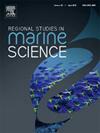玳瑁幼龟可见光探测阈值的研究
IF 2.1
4区 环境科学与生态学
Q3 ECOLOGY
引用次数: 0
摘要
光是孵化的海龟从巢中出来后寻找海洋的主要环境线索。航海过程会被任何比自然环境光强的光线打断。研究人员对7种海龟中的3种进行了调查,以确定它们对可见光谱中不同波长光的探测阈值,以帮助减少孵化的海龟定向错误。然而,玳瑁还没有被调查过,它们普遍喜欢在植被下筑巢,而不是在开阔的沙滩上,这证明了它们的视力可能比其他物种对低光强度更敏感的假设是正确的。通过y迷宫选择实验,确定了雏鹰对415、470、535、5555、590、601和660 nm的可见光的检测阈值。玳瑁对555 nm的光最敏感,对660 nm的光最不敏感,与之前研究的海龟物种相比,其检测阈值处于中间水平。我们的结果可能对通知海滨照明的变化至关重要,因为我们说明,即使在非常低的强度下,穿过可见光谱的光仍然可能吸引和误导玳瑁孵化。本文章由计算机程序翻译,如有差异,请以英文原文为准。
Thresholds of visible light detection in hawksbill turtle (Eretmochelys imbricata) hatchlings
Light is the primary environmental cue that hatchling sea turtles use to find the ocean post-emergence from the nest. The process of seafinding is interrupted by any form of light stronger than natural, ambient light. Three of the seven species of sea turtles have been investigated to determine their thresholds of detection for various wavelengths of light across the visible spectrum to help reduce hatchling misorientation. Hawksbill turtles, however, have not yet been investigated, and their general preference for nesting under vegetation, rather than on open sand, justifies the hypothesis that their vision may be more sensitive to lower light intensities than other species. Using a Y-maze choice experiment, we discerned the detection threshold for hawksbill hatchlings for visible light of 415, 470, 535, 555, 590, 601, and 660 nm. Hawksbills were most sensitive to light of 555 nm, least sensitive to light of 660 nm, and exhibited detection thresholds that are intermediate compared to previously studied species of sea turtles. Our results may be critical for informing changes in beachfront lighting, as we illustrate that even at very low intensities, light across the visible spectrum may still attract and misorient hawksbill hatchlings.
求助全文
通过发布文献求助,成功后即可免费获取论文全文。
去求助
来源期刊

Regional Studies in Marine Science
Agricultural and Biological Sciences-Ecology, Evolution, Behavior and Systematics
CiteScore
3.90
自引率
4.80%
发文量
336
审稿时长
69 days
期刊介绍:
REGIONAL STUDIES IN MARINE SCIENCE will publish scientifically sound papers on regional aspects of maritime and marine resources in estuaries, coastal zones, continental shelf, the seas and oceans.
 求助内容:
求助内容: 应助结果提醒方式:
应助结果提醒方式:


